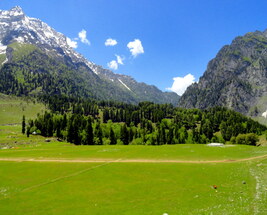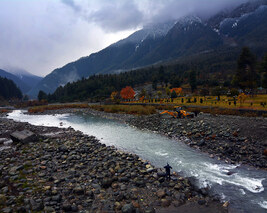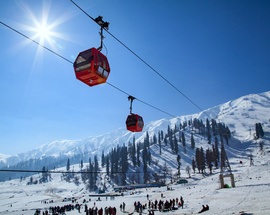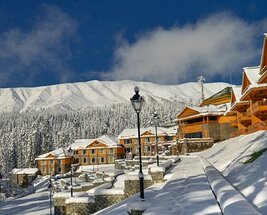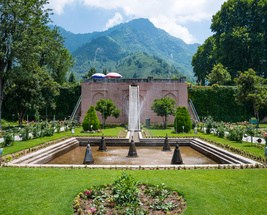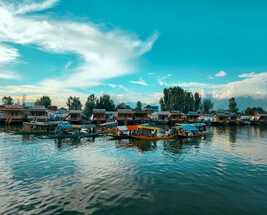Best Time to visit Gulmarg
Paradise is within our reach because of hill stations such as Gulmarg. Tucked away in the western Himalayas, of the Indian state of Jammu and Kashmir, this little oasis quite literally floats in the sky. One of the nations most renowned ski destinations, it attracts tourists of varying kinds – solo travellers, honeymooners and young families. Gulmarg is electrifying in every way. It is an ethereal town, with an abundance of natural beauty, adventure sports facilities, heritage and religious sites.
This tiny hamlet is also one of the few destinations in our country where footfall is present all through the year, and we’re not surprised about this! Winter, summer and monsoon, each has its allure and charm and all seasons are preferred as the best time to visit Gulmarg. While the former is perfect for snow studded sports, the latter is ideal for romancing nature, while the period in between is most pleasing for fun family outings. When you’re contemplating over the best time to visit Gulmarg, you will find it handy to look at pages such as these!
We’ve broken down each pronounced season, offering insights, tips and risks for you to mull over. Now, you can make the most optimal decision and plan the perfect trip.
Peak Season – March to June
Shoulder Season – October to February
Low Season – July to September
|
Travel Seasons
|
Min/Max Temperature
|
Season
|
|
October to March
|
-4 to 11°C
|
Winter - Glacial
|
|
April to June
|
13 to 29°C
|
Summer - Pleasant
|
|
July to September
|
18 to 35°C
|
Monsoon - Minimal rainfall
|
Gulmarg in Winter – (October to March)
Temperature – The air temperature during the season of winter fluctuates between -4°C and 11°C.
Weather – Winter creeps in during October. The atmosphere becomes frosty and temperatures begin to fall. By November, the climate reaches the sub-zero range, with winds getting progressively stronger. By December, the landscape is blanketed in thick sheets of snow – glistening and pearly white. Heavy snow only starts to fall in early January, lasting until mid-February.
Significance – Gulmarg is your typical winter wonderland, a delightful little hamlet for all kinds of adventure sports. From skiing to snowboarding, driving snow scooters to wooden sledges, gondola rides and cable cars, there are so many different ways to experience the magical phenomena of snow! We’d recommend visits to Strawberry Valley, Alpather Lake, Alpharwat Peak and last but not least – The Ski Resort.
Why you should visit now – Winter is the best season to visit Gulmarg in, to bask in the glory of snow, slate and serenity (and, the thrilling sports don’t hurt too!). There is perhaps nothing as surreal or extraordinary as witnessing live snowfall. Picture snow-covered meadows, snow-frosted peaks, snow icing treetops and snow manicured grounds. To bare witness to this is simply breath taking.
Things to know before the visit – There is a risk of snowstorms occurring during this season, due to which roads can get blocked. Be wary of excessive snowfall that can hamper routes and connectivity. The guides in Gulmarg will try and convince you that their services are required, don’t fall for their aggressive selling techniques.
Tips – Pack your bag with woollens as the temperature can get very severe. Scarves, gloves and mufflers are a necessity to shelter you from the cold breeze. Invest in some good quality thermals, wind/waterproof jackets and ankle-length snow boots. The proper attire is imperative and should not be compromised. Ensure that your hotels have heaters and/or electric blankets, which usually is the case.
Gulmarg in Summer – (April to June)
Temperature – The air temperature during the season of summer fluctuates between 13°C and 29°C.
Weather – Weather of Gulmarg in summer is far more pleasant than that of winter as temperatures are higher and the sun is friendlier. The days are graced with a pleasing and comfortable climate, apt for sightseeing and adventure sports. You will discover less snow on the ground, but this paves the way for blossoming and blooming flowers.
Significance – Summer infuses the landscapes and sceneries with intense clarity. The views of the mountains, valleys, lakes and waterfalls are crystal clear and gorgeous. The landscapes are littered with flowers of varying kinds, like a painting. Some of the recommended visits include – Gulmarg Golf Course, Gulmarg Biosphere Reserve, Children’s Park and Khilanmarg.
Why you should visit now – As a former British summer retreat, this hill station has all the makings of a perfect getaway! During this time, there is a little bit of snow, a whole lot of sunshine and even more flora. The air is lovely and the atmosphere doesn’t make you want to sniffle! As such, summer is the best climate to visit Gulmarg in to engage in a plethora of activities, visits and explorations.
Things to know before the visit – This is the season for day-trippers and families. As peak tourist season, travel and lodging will be more expensive. Hence, plan your trip well in advance. When it comes to the tour guides, be careful as they work on a commission basis.
Tips – Your attire should take into consideration the elevation of this hill station. Although it’s the season of summer, the climate is still cold. Do not let the sun fool you. Ensure that you pack warm clothing.
Gulmarg in Monsoon – (July to September)
Temperature – The temperature during the season of monsoon fluctuates between 18°C and 35°C.
Weather – Like in the case of most hill stations, Gulmarg during monsoon is a mystical affair. The temperatures are generally favourable, creating an ideal atmosphere for tourists to revel in. However, it can sometimes become quite warm and muggy. The moderate showers paint the landscape with an artistic touch.
Significance – It may be obvious to say that hill stations transform during the period of monsoon, shedding dull layers to shine in beauty and brilliance. Monsoon may not be the best time for outdoor excursions, but that doesn’t mean you can’t enjoy strolls. Furthermore, there are alluring indoor sights to traverse. Here are the best places to visit during this period - Maharaja Place, St. Mary’s Church, Maharani Temple, Ningle Nallah and Ferozepur Nallah.
Why you should visit now – Rain is the secret ingredient to creating the most enchanting and mystical setting. From soft violet clouds to deep emerald greens, the surroundings take on magnificent beauty. The hills sing to the tune of the showers, something unique to this season only. Where else can you enjoy a cup of garam tea, whilst looking over unadulterated mountainous beauty?
Things to know before the visit – As this is off-season, hotels will offer great deals to attract customers. One must take advantage of these affordable prices. When it comes to adventure sports such as skiing and trekking, it will go up to the discretion of the authorities to allow tourists to engage in it or not.
Tips – Pack wind/rainproof clothing, gumboots and an umbrella. Make sure your camera, smartphone, or other devices are well protected. Before venturing out, check the forecast for the day. Do not self-drive, hire a car.





